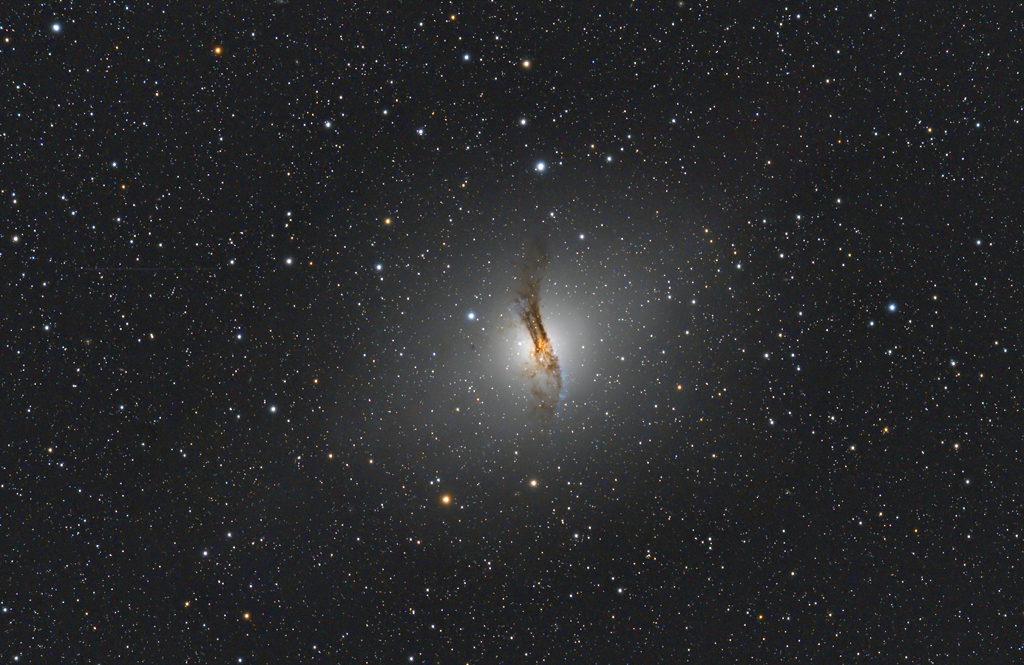 |
CHAMÄLEON + ONJALA OBSERVATORY DeepSky | SITEMAP HOME CHAMÄLEON |
|
 |
|||
| « back to overview galaxies | Load higher resolution (1800 x 1800 Pixel) | Object description |

Centaurus A is one of the most remarkable galaxies in the southern sky, both in view and in its multiple structures. At a distance of "only" 11 million light-years, it is very close to the solar system and therefore one of the best studied galaxies outside the local group. Together with Messier 83, Centaurus A forms the center of a close galaxy group outside the local group.
It is the closest radio galaxy to our Milky Way and the third brightest radio source in the sky. There is still disagreement among astronomers about its morphological type, with some researchers classifying it as an E(p) type elliptical galaxy and others as a S0 type lenticular galaxy. Its characteristic optical feature here is the clearly visible "bent" dust band that crosses the galaxy.
It seems clear that Centaurus A is probably the result of the merger of a large elliptical galaxy with a smaller spiral galaxy several hundred million years ago. This is indicated by the spectacular dust band that runs across the entire galaxy. In addition, in certain spectral ranges a "spiral structure can be detected in the core region. The collision and merger triggered a violent star formation phase and, in addition, gas masses were deflected from their original orbits and partially gathered around a black hole in the center. A black hole with the mass of 55 million solar masses is suspected in the center. The active galactic core, hidden by this dust band, emits most of the high energy radiation and also radio radiation. In addition, Centaurus A is a powerful source of X-rays and gamma rays.
The enormous energy output of Centaurus A comes from gas falling into the central black hole. Parts of these gas masses are ejected from the black hole in two opposite jets at a considerable fraction of the speed of light. The details of this process are still unclear. The jets interact with the surrounding gas and probably influence the rate of star formation of the galaxy.
Centaurus A was discovered by James Dunlop on August 4, 1826. He included the object in his "Catalogue of Nebulae and Clusters of Stars in the Southern Hemisphere observed in New South Wales." Centaurus A was classified as a strong radio galaxy in 1949 by John Bolton, Bruce Slee and Gordon Stanley.
 |
« The image on the left shows a composite image of
NGC 5128, which also shows the lobes and jets emanating from the galaxy's
central black hole. The image represents data together obtained from three
different instruments operating in different wavelength ranges. Shown in orange
are submillimeter data at a wavelength of 870 microns taken with the LABOCA
camera on the APEX telescope. X-ray data from the Chandra satellite appear in
blue. The visible light images are from the Wide Field Imager (WFI) on the
MPG/ESO 2.2-meter telescope on La Silla in Chile and show background stars and
the dust band characteristic of this galaxy in near true color. Credit: ESO/WFI (Optical); MPIfR/ESO/APEX/A.Weiss et al. (Submillimetre); NASA/CXC/CfA/R.Kraft et al. (X-ray) Click here or the thumbnail to load a large image |
 |
 |
 |
 |
 |
 |
 |
| Sonne | Mond | Sonnensystem | DeepSky | Weitwinkel | Verschiedenes | Spez. Projekte |